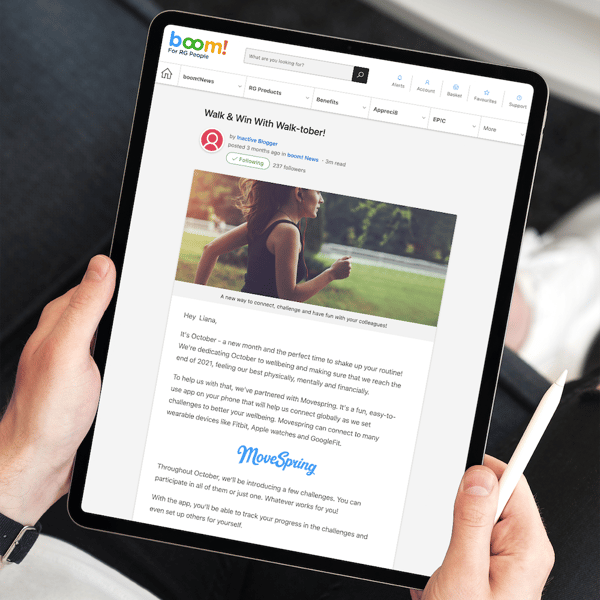In the War for Talent, company culture is a main reason that employees stay with a company. If it isn't carefully cultivated, an organisation may be at risk of losing its best people.
And a supportive company culture incorporates wellbeing. If your organisation doesn’t have healthy wellbeing goals in place, employees may struggle with fatigue and burnout, which can lead to poor engagement and employee retention.
As the work landscape is ever-changing due to the pandemic, it’s important for employers to develop ways to make sure their employees are happy, healthy and engaged.
Try following these five steps to create employee wellbeing goals that boost employee engagement and wellness in the workplace as we head into 2022.
| 1. Identify what's important to you and your employees |
| 2. Develop and execute your employee wellbeing programme |
| 3. Focus on mental health awareness, resources and support |
| 4. Promote attention to physical wellbeing |
| 5. Improve financial wellbeing |
1. Identify what's important to you and your employees
Goals are important parts of life. But before setting a goal, you have to ask yourself why it matters.

But the most important piece of the puzzle in setting goals? You've got to be SMART:
- Specific
- Measurable
- Agreed
- Relevant
- Time-bound
For example, running a marathon could be cool, but why? Are you looking to raise money? Get in shape? Do something new that challenges you? If you’re doing it just because, chances are you won’t chase the goal.
The same goes for setting goals that boost employee wellbeing and engagement. Get specific to set a worthy goal that you’re actually going to meet. Ask yourself the following questions to get to the bottom of what’s important to you and your employees.
- What does your business need this year? Maybe you’re looking to simply increase revenue. Or attract more customers. Or expand to other markets. Your company goals should line up with your internal goals since employees are the ones who’ll be executing the plans to meet them.
- What are employees telling you? Pay attention to what employees are saying. In meetings, emails and other communication channels (employee surveys, job sites and even exit interviews), examine the feedback. Are you seeing any patterns or repeat complaints?
- Have I talked to my employees? Interacting with employees at all levels is an important part of building rapport. Be in communication with everyone to learn what’s important to them and the overall mood of the organisation. Whether people are remote or in the office, you can communicate more through meetings in person or over tools like Zoom, Slack and company-wide blog posts.
- What worked in the past? Perhaps there was a project that was successful in recent years. Take time to look at projects and initiatives that have already been delivered. Analyse their lifespan and success.
2. Develop and execute your employee wellbeing programme
An Employee Value Proposition (EVP) combines every aspect of the employee experience, from salary to the wellbeing allowance offered to the weekly leadership blog. It's all the things that make your organisation an attractive place to work.
Put simply, an EVP answers the questions: 'Why do people work here?' and 'What’s special about your company?'
HR leaders realise the EVP must change from 'we want to keep you here' to 'we want to keep you inspired and supported here.'
While there are countless ways to build your EVP, the organisations that will thrive are paying close attention to core ways to evolve.
Part of this proposition is your employee wellbeing programme, which can be filled with tools and content to boost the four pillars of employee wellbeing: mind, money and move. These might look like how-to videos, apps, care packages, health tips and advice, access to healthcare and fun perks.
3. Focus on mental health awareness, resources and support
The stigma surrounding mental health is lifting. Increasing awareness and support in your workplace can help make mental health even easier to address.
Talk about the importance of mental health with employees. Note the symptoms of common mental health issues like anxiety, depression and burnout so everyone can notice and identify them.

Finally, provide resources and support, such as access to:
- Therapy
- Healthcare
- Healthy living tips and facts
- Self-care incentives
- Nutritious meals and snacks
- Flexible schedules
- Physical fitness opportunities
- Opportunities to share their story with others
Here at Reward Gateway, we started a wellbeing series called LevelUp. Each week, one of our global employees shared their mental health story with the rest of the organisation on our internal communications platform. This format helped everyone feel more connected and inspired to prioritise their own wellness journeys, which was seen in all of the comments left on the blog posts.
4. Promote attention to physical wellbeing
Encourage employees to take care of their physical health. When the body is in good shape, it can reduce stress as well as improve productivity and mood.
Don’t just promote physical health, though. Give your employees the tools they need to do it:
- Avoid sitting down too much
- Take screen breaks
- Allow time to get outside or work outside
- Make room for flexible commutes
- Provide healthy choices in the canteen or during catered events
Unsurprisingly, sitting at your desk for long periods of time proves to be counterproductive. The People Team at RG wanted to encourage our global employees to get up, go outside and get moving. Using our employee communications tool, we launched a brand new challenge called Walk-tober. Our original collective goal was one million steps.

But we’re a competitive bunch and knocked that out of the park – reaching 10 million steps for the month of October! We shared the results with the organisation and received an outpouring of support and gratitude for starting this challenge, which encourages us to do more of these to help our people prioritise physical wellbeing.
5. Improve financial wellbeing
As people around the world have felt the financial impact of the pandemic, they are realising that it's more important than ever to have savings to fall back on.
When finances are uncertain, it can cause extreme stress, worry and panic. This can result in rash decisions, the need for additional jobs (despite a lack of capacity) or the risk of more instability by taking out loans.

Boosting the financial wellbeing of employees can be a game-changer that helps them financially, mentally and physically. Some ways to do this are through:
- Employee discounts
- Rewards
- Salary sacrifice benefits such as Cycle to Work
- Savings programs
- Employee assistance programmes
- Financial education programmes
Despite the challenges of the pandemic, you have the opportunity to show employees that you care about their wellbeing. By recognising the signs that people need support and providing them with the right systems, you’ll make a difference in their lives. Without healthy wellbeing goals in place, employees may continue struggling with fatigue and burnout.
The key to creating a successful employee wellness programme is finding a partner or provider that will help you take a holistic approach to financial, physical, and mental wellbeing. Reward Gateway understands the importance of engaging your entire workforce, catering to their multifaceted wellbeing needs, and building solutions that everyone will embrace.

 Catrin Lewis
Catrin Lewis


